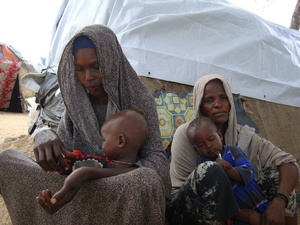Somali displacement grows rapidly as fighting rages
Somali displacement grows rapidly as fighting rages
The number of Somalis forced from their homes in Mogadishu has now topped 96,000 since the start of fighting between government forces and armed opposition groups on May 8.
Out of this latest total of displaced, an estimated 35,000 are still in the city, looking for shelter in more secure areas because they have no means to leave. Some 26,000 have managed to flee to makeshift sites in the so-called Afgooye corridor about 30 kms south-east of Mogadishu, joining 400,000 internally displaced people (IDPs) already sheltering there. The remaining 35,000 have fled to other parts of Somalia. Some of them are also making their way towards neighbouring countries.
According to UNHCR's local partners in Somalia, some 2,000 people have indicated that they plan to cross the border into Kenya. More than a thousand said they are ready to risk their lives and make the perilous journey with smugglers across the Gulf of Aden to Yemen. Some 600 people told our local partners they were heading towards Ethiopia.
In neighbouring Kenya, the number of new arrivals from Somalia spiked from an average of 100 a day to nearly 200 over the past week. Since the beginning of the year, almost 32,000 people have crossed into Kenya, bringing the total number of Somali refugees in the country to more than 297,000.
We continue to rush aid to the displaced in Somalia. UNHCR's local partners have just completed the first phase of an aid distribution south of Mogadishu. Deliveries of UNHCR aid items began on Tuesday 26 May and 12,600 people received plastic sheeting, sleeping mats, kitchen sets, blankets, jerry cans and sanitary pads in Kah Shiqal area of southern Mogadishu.
The next phase of aid distribution was scheduled to start earlier this week in the vicinity of a location called Kilometer 13, on the south-eastern outskirts of the Somali capital. During this phase we had hoped to provide humanitarian assistance to almost 30,000 people but the distribution was halted due to fighting between opposition groups and government forces for the control of the main road from Mogadishu to the Afgooye district.
UNHCR is leading a task force to coordinate the response and interventions of all humanitarian actors in this new emergency.



